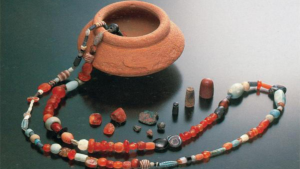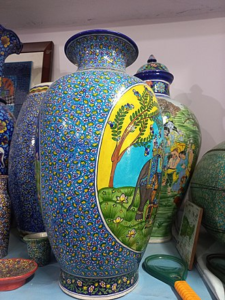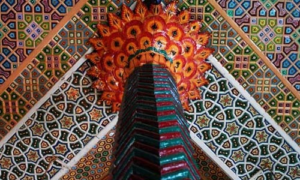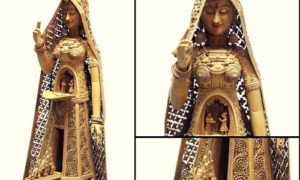The world of art and craft is just as valuable as science, philosophy, and ethics. Crafts, like art, are a reflection of our society through individual expression. Each person carries aspects of the collective human experience, and craft treasures give us a glimpse into the core of our shared mind through their creators. No craft object is made just for its beauty or color; each one serves a purpose—whether it’s practical, religious, or social. Think about the fragments of vases from the Indus Valley, the carved metal bowls and tiles from the Euphrates, or the wooden toys and gold ornaments from the Nile. All of these items genuinely reflect the cultures of their respective bygone eras.
Wooden handicrafts, in particular, are made by decorating or carving wood into beautiful items, with each craftsman creating something unique based on their individual talent. India, known for its rich tradition and culture, has handicrafts that are deeply woven into its customs. From intricately woven textiles and hand-painted ceramics to ornate metalwork and vibrant paintings, these crafts tell stories of India’s history, spirituality, and way of life.
Indian Handicrafts
The history of crafting unique and beautiful items in India has been passed down through generations. India offers a stunning variety of jewelry, handmade paintings, and exquisite woodcrafts that are truly one-of-a-kind and can only be found in this vibrant country.
Origin
As the sun rose, signaling the start of a new day, the citizens of the ancient Indus Valley civilization emerged from their homes to witness a vibrant scene. Throughout towns and cities, workshops and factories bustled with activity. Skilled craftsmen were diligently creating a variety of goods: some meticulously arranged precious beads into stunning necklaces, while others crafted elegant bangles from ivory and shell. There were artisans designing exquisite headdresses, shawls, and skirts, and dedicated craftsmen fashioning toy carts and well-formed figurines from clay and wood.

Once the products were ready, they were taken to markets within and beyond the Indus Valley. Some items were sent to major centers like Mohenjo-daro and Harappa. Harappans spent their days mastering crafts, collecting materials, manufacturing goods, transporting them on bullock-carts, and arranging them in shops. After work, they returned home as workshops closed and the day ended with the glow of handcrafted earthen lamps. The Indus Valley civilization thrived 5000 years ago in what is now India, Pakistan, and Afghanistan. Today, echoes of these handicrafts can still be seen in our household decor.
Evolution
Initially, Indian handicrafts focused on everyday items like pottery, baskets, and textiles. As trade grew, so did the demand for these crafts, prompting artisans to develop new techniques and styles to meet changing needs.
With the arrival of different rulers over history, Indian handicrafts evolved through cultural blends, creating new designs and methods.
- During the Mughal period, arts like marble carving, miniature painting, and metalwork thrived with royal support.
- British rule introduced modern machinery for mass production but also expanded markets for traditional artisans, blending Indian craftsmanship with Western influences.
- After independence, there was a revival of traditional crafts to preserve cultural heritage. Organizations like the All India Handicrafts Board promoted Indian crafts globally, supporting artisans with training and facilities.
Indian handicrafts have evolved over time, each era leaving its mark. Today, they are essential to India’s cultural identity and provide vital employment in rural areas.
Crafts like Madhubani painting from Bihar, Phulkari embroidery from Punjab, Pattachitra paintings from Odisha, and Banarasi silk sarees from Uttar Pradesh are timeless examples celebrated for their beauty and craftsmanship.

Discovering the Rich World of Indian Handicrafts
Each region of India is famous for its unique and exquisite handcrafted treasures, reflecting the creativity, skills, and aesthetics of local artisans. The wide array of Indian handicrafts showcases the country’s diversity and the intricate artistry that goes into making each piece.
Textile Crafts
Indian textile crafts are celebrated worldwide for their beauty, intricacy, and craftsmanship. From traditional handloom sarees like Banarasi, Kanjeevaram, and Chanderi to block printing techniques like Bagh, Ajrakh, and Dabu, each region has its own distinct style. Kashmir’s famous Pashmina shawls, embroidered with delicate silk thread designs, are symbols of luxury, while Gujarat’s Bandhani or tie-dye technique produces vibrant fabric patterns.
Pottery and Ceramics
Pottery is an ancient craft in India with different styles found in various regions. The blue pottery from Jaipur stands out for its vibrant colors, while terracotta pottery from West Bengal features intricate nature-inspired designs. In Auroville, Tamil Nadu, you can find contemporary ceramic pieces made using sustainable methods.

Metalwork
Metalworking is another popular craft in India, with various techniques used across the country. Bidri work from Andhra Pradesh involves carving intricate patterns on black metal, while Dhokra art from Odisha uses lost-wax casting to create tribal figurines. Silver filigree work from Cuttack and copperware from Moradabad are also highly sought after for their fine craftsmanship.
Folk Art
Folk art plays a significant role in preserving India’s cultural identity through generations. Madhubani paintings from Bihar depict mythological stories using bright colors and elaborate details. Warli paintings from Maharashtra use geometric designs to showcase the community’s way of life. Pattachitra from Odisha, Phad paintings from Rajasthan, and Kalamkari from Andhra Pradesh are traditional folk art forms that continue to thrive.
Paper Crafts
Paper crafts in India have a history dating back to the Mughal era. Intricately designed papier-mâché products from Kashmir have gained global recognition, while Sola wood sculptures from West Bengal and quilling from Gujarat are unique forms of paper crafts. Handmade paper products like notebooks, diaries, and stationery items made in Jaipur using eco-friendly techniques are also noteworthy.
From textiles to pottery, metalwork to folk art, India’s rich heritage of handicrafts has something for everyone to admire and cherish.
Wooden Crafts
Wood carving in India has a long and diverse history, closely connected to the cultural, religious, and artistic traditions of the region. Over many centuries, Indian wood carving has developed, blending skill, creativity, and spiritual meaning. Let’s explore the historical path of wood carving in India.
Origin
Wood carving in India began long ago, dating back to ancient civilizations like the Mauryan and Gupta periods (circa 500 BCE – 500 CE). During this time, artisans crafted intricate wooden artifacts for temples, palaces, and royal homes. These carvings often depicted mythological stories, gods, and scenes from daily life.
As time progressed, especially during the Gupta Empire and later dynasties, wood carving thrived. It reached its peak during the medieval period, particularly in regions such as Odisha, Rajasthan, and Karnataka. Temples in places like Khajuraho, Konark, and Halebid showcased exquisite wood carvings of celestial beings, religious stories, and elaborate floral designs.
Wood carving wasn’t limited to religious buildings but also adorned royal palaces and the homes of wealthy families, reflecting the craftsmanship’s integration into both structural and decorative arts.
Evolution of Wooden Crafts
As Islamic rule spread in India, wood carving adapted to incorporate Persian and Central Asian influences. The art form evolved with intricate geometric designs, arabesques, and beautiful calligraphy gracing wooden artifacts. This period saw a unique blend of Hindu and Islamic artistic elements, evident in structures like the stunning wooden interiors of Mughal forts and palaces.
However, during the colonial period, European powers introduced new techniques and styles to Indian wood carving. This influenced the aesthetic direction of the craft, adapting it to meet changing tastes. Even after independence, wood carving remained significant, finding expression in modern furniture, religious artifacts, and decorative items.
Today, Indian wood carving continues to thrive, blending ancient traditions with contemporary designs. It’s not just about craftsmanship; it’s a testament to India’s enduring cultural heritage, cherished and celebrated across the world.
Regional Styles and Influences: Exploring India’s Wood Carving Traditions
India’s diverse cultural landscape has given rise to unique regional styles of wood carving. Let’s take a journey through some of these remarkable traditions:
Kashmiri Wood Carving
Kashmiri wood carving stands out for its remarkable delicacy, featuring intricate floral patterns and meticulous lattice work. The artisans of Kashmir, inspired by the serene landscapes and cultural heritage of the region, create pieces celebrated for their unparalleled intricacy. This style often finds expression in furniture pieces and screens, mirroring the natural beauty and cultural richness of Kashmir.

Rajasthani Wood Carving
Rajasthani wood carving is a vibrant celebration of colors and intricate designs, reflecting the cultural opulence and historical influences of the Rajput and Mughal eras. The artistry, marked by regal grandeur, appears in ornate furniture and decorative panels. Rooted in Rajasthan’s rich history, this style weaves a visual tapestry that narrates the region’s royal legacy.

South Indian Wood Carving
South Indian wood carving is predominantly expressed through temple architecture, with depictions of deities, mythological scenes, and ornate motifs transforming sacred spaces into visual narratives of divine stories. This carving style, rooted in the religious and mythological traditions of South India, adorns the pillars, doorways, and sanctums of temples, reflecting the devotion and artistic brilliance of the region.
Uttar Pradesh Wood Carving
Uttar Pradesh, particularly regions like Saharanpur, is acclaimed for its masterful creation of detailed and ornate wooden furniture. Known for its export-quality craftsmanship, the intricate carvings on tables, chairs, and cabinets reflect the state’s dedication to preserving and evolving its rich woodworking tradition.
Himachali Wood Carving
Himachal Pradesh, nestled in the mountains, has a distinctive wood carving tradition influenced by its natural surroundings. The carvings frequently depict local flora, fauna, and mythological motifs. Wooden panels, doors, and architectural elements in traditional Himachali homes showcase the unique wood carving style, reflecting a deep connection to the mountainous landscape.
West Bengal Wood Carving
West Bengal’s wood carving tradition draws inspiration from its cultural diversity, resulting in artifacts with intricate designs influenced by the state’s folklore and traditions. Wooden sculptures, masks, and artifacts are used in religious ceremonies, festivals, and cultural events, showcasing the adaptability of wood carving to diverse cultural influences.
These regions collectively contribute to India’s diverse wood carving heritage, reflecting the nation’s cultural vibrancy, local aesthetics, and the skillful evolution of this ancient craft.
Indian Handicrafts Online and Wooden Crafts Redefining USA Home Decor
The handicraft industry in India plays a huge role in the country’s economy. In 2021-22, the market size was a whopping $3,968 million, with a big chunk of that coming from exports. India is one of the top exporters of handicrafts globally, with the USA, UK, and Germany being major markets.
The rising demand for Indian handicrafts in home decor has positively impacted the preservation of traditional techniques. Many of these methods, like hand-block printing and metal casting, are at risk of fading away with the rise of modern manufacturing. By choosing handmade, traditional items, consumers are helping to keep these techniques alive and ensuring they’re passed down to future generations.
Here are some of the top handicraft products that India exports to the USA:
1. Textiles and Fabrics
India’s textile industry is famous for its vibrant colors, intricate designs, and diverse fabrics. Handmade textiles like sarees, shawls, and scarves are especially popular in the USA. Techniques such as Banarasi, Kanjeevaram, and Ikat weaving make these textiles highly sought after by those who appreciate true artistry.
2. Metalware and Brass Handicrafts
India has a long history of metal crafting. Brass and metalware items like figurines, utensils, and decorative pieces showcase the incredible skill of Indian artisans. These items are cherished in the American market for their intricate designs and rich colors, adding a touch of cultural significance to any space.
3. Wooden Handicrafts
Indian wooden handicrafts have a timeless charm. Carved with precision and adorned with beautiful motifs, items like wooden furniture, sculptures, and decor pieces made from Sheesham and Teak are highly valued in the USA. These pieces often tell stories of mythology, folklore, and spirituality, bringing a sense of cultural depth to American homes.
4. Pottery and Ceramics
India’s pottery and ceramics are as diverse as its cultural landscape. From the famous blue pottery of Jaipur to the terracotta works of West Bengal, these items add an authentic touch to homes. Pottery pieces, including dinnerware and ornamental objects like vases and sculptures, blend functionality with artistry.
Other Noteworthy Mentions
Carpets: Hand-woven carpets from regions like Jammu Kashmir and Rajasthan are prized additions to many American homes.
Zari and Zari Products: These items, embellished with exquisite gold and silver threads, add a touch of luxury and history to textiles and accessories.
The popularity of each category may vary depending on current trends and regional preferences within the USA. However, Indian handicrafts consistently offer a unique blend of heritage, artistry, and affordability, making them a favorite among American buyers.
Sustainability and Environment
In an era where sustainability and ethical sourcing are paramount, Indian handicrafts stand out for their eco-friendly practices and artisanal integrity. Many craftsmen use locally sourced materials and traditional techniques, ensuring minimal environmental impact and promoting fair trade principles.
Eco-conscious consumers in the USA are increasingly drawn to Indian handicrafts made from sustainable materials such as bamboo, jute, and recycled textiles. Handwoven baskets, eco-friendly rugs, and upcycled home accessories not only enhance decor but also support eco-friendly lifestyles and responsible consumption.
Conclusion
Indian handicrafts play a big role in home decor, benefiting both the economy and many artisans’ livelihoods. When people buy these handmade items, they add unique, authentic pieces to their homes while also helping preserve cultural heritage and supporting the communities that create them.
